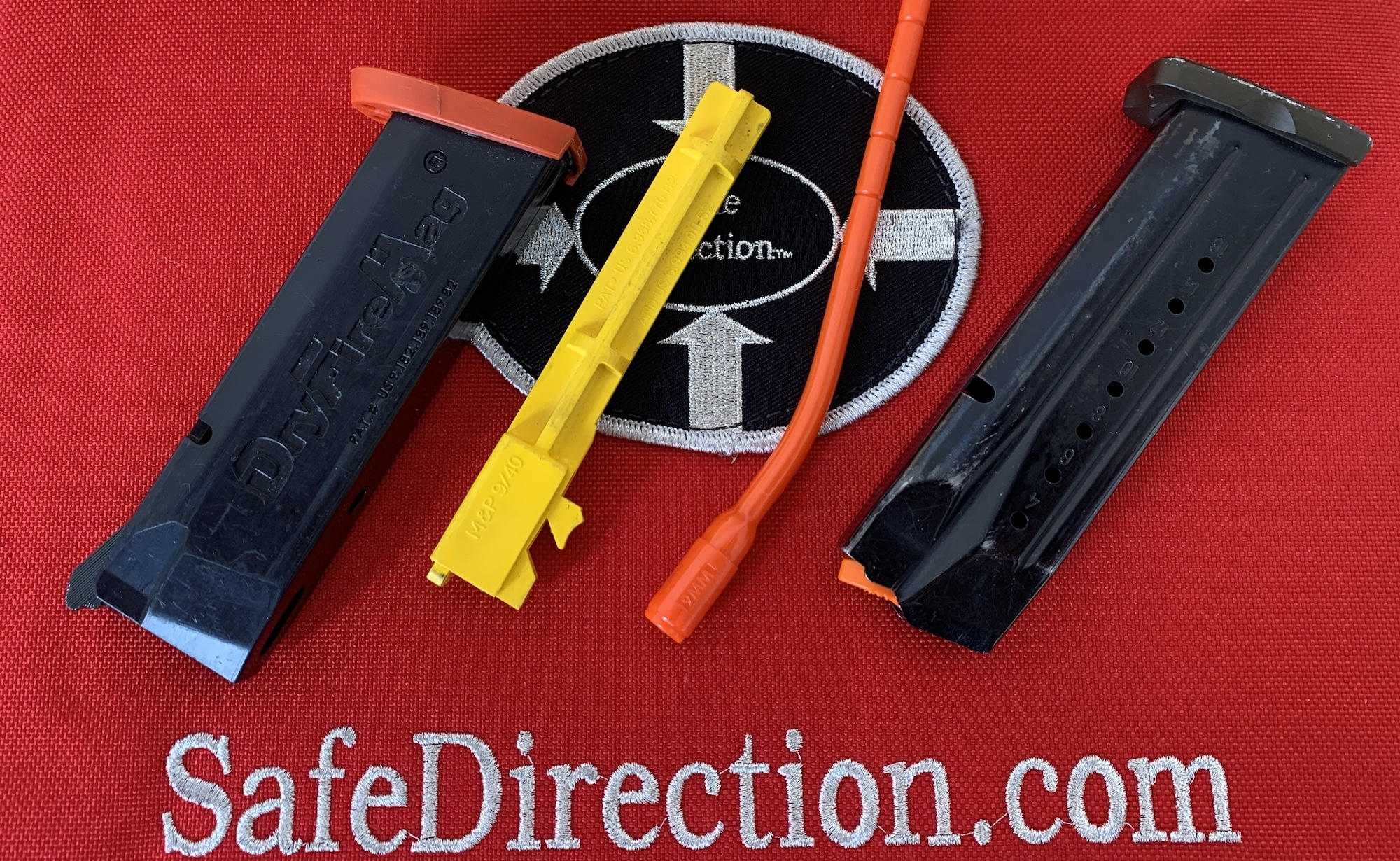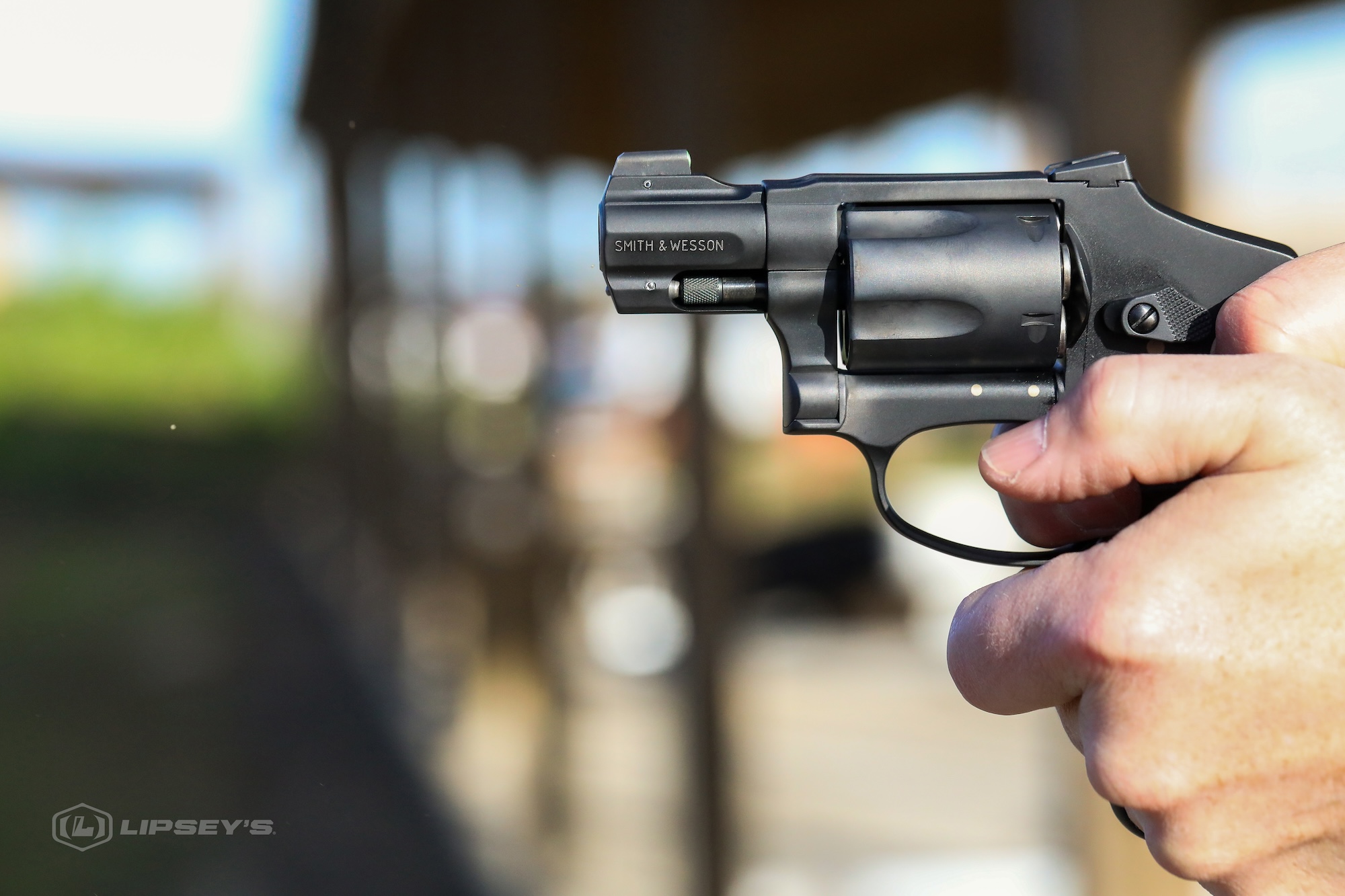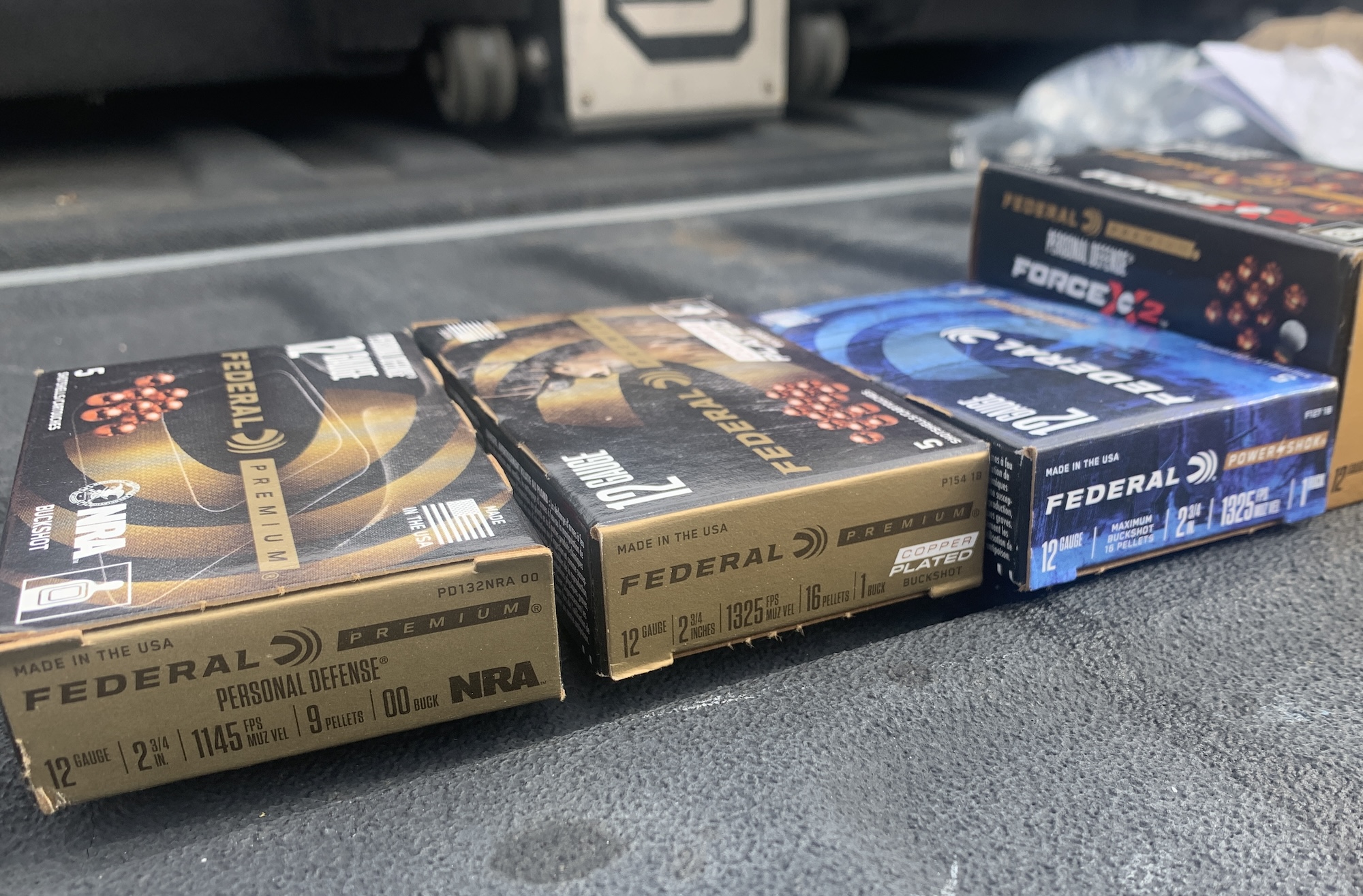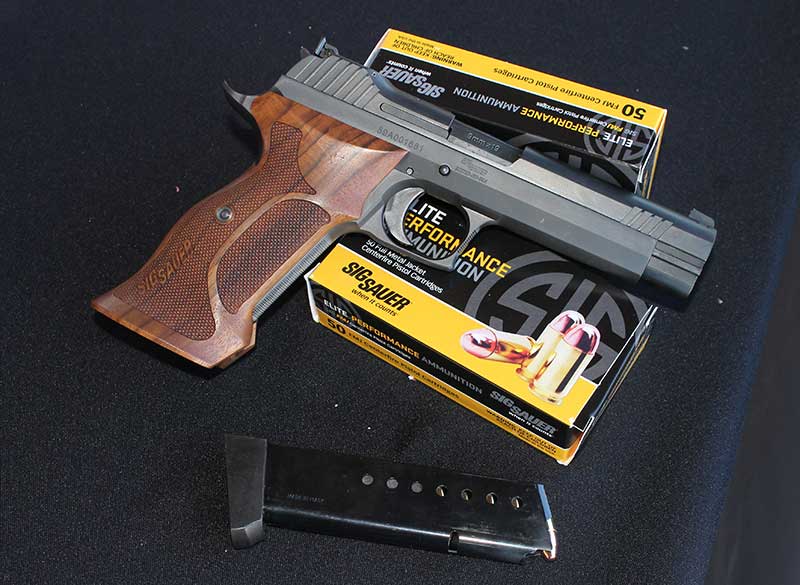
AH18-EX-SIG-1B
Made In America: Legendarily Accurate Competition Classic
SIG’s original military Model 210 was introduced in 1949 and shipped with a 50-meter test target with a 5-shot, sub-2″ group, establishing a reputation for stellar accuracy. Variations served the Swiss military until the early 21st Century and created a solid niche market among civilian shooters and collectors.
The current made-in-USA version, the P210 Target arrived on dealer shelves late last year. It features excellent target sights and walnut sport grips reminiscent of the old S&W “Coke bottle” stocks. The fine-line 25 LPI checkering on the frontstrap and triggerguard contribute to the solid purchase afforded by the grips and add to the classy appearance of the pistol. In short, The American P210 Target melds Swiss design with the improved ergonomic features preferred by modern shooters.
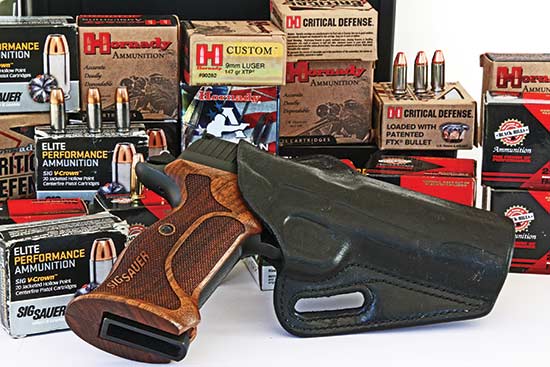
Mike’s 1911 GALCO holster fits the P210 Target like a glove. Basic 9mm practice ball ammo is plentiful at bargain basement prices and fully vetted premium defensive rounds from the major manufacturers are widely available
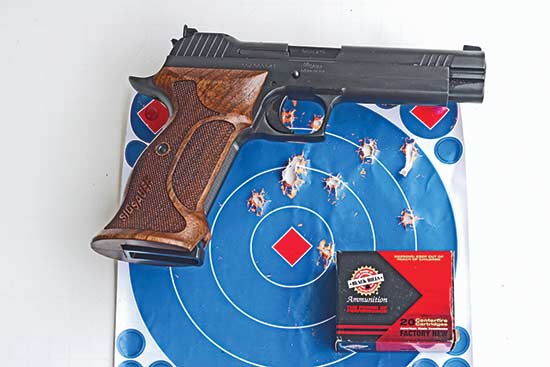
This 25-yard group — shot offhand using both hands — shows the intrinsic potential of the SIG P210 Target.
Tweaking The Template
Western-inspired changes found on the P210 Target began in 2010 with replacing the heel release with a frame-mounted magazine button and a heavier frame with the German-made Legend series. This incorporated a safety lever that wouldn’t score the frame and a beavertail to eliminate blood-letting from a hammer bite.
An important development in the late-Legend period was moving the thumb safety from grip-front to the much more accessible 1911-like over-grip location. The two 8-round magazines included with the P210 Target are marked “Made In Italy” and also fit the German-made Legend pistols. The P210 Target mags have base pads of additional length to match the sport/target grips.
The American P210 Target is effectively the same size as my Les Baer 1911 TR Special and within a few ounces of it in terms of weight. It has the same 5″ barrel, but overall length from beavertail to muzzle is 1/4″ less. Overall height from the top of rear sight to bottom of grip is the same 6″ as the Baer with a bump-pad magazine installed.
The grips on the P210 Target are wider than those of the Baer and the slide marginally so — though my 1911-blocked Galco belt holster fits it like a glove and conceals it very well with a light cover garment.
In place of the internal matching lugs of the original 210, the raised chamber interfaces with the slide port — a change that’s every bit as precise, yet one that permits more economical production.
After several hundred rounds and some holster carry, the finish on the slide, barrel and frame — in contrast to my experience with the 210 Legend — shows no wear, “high spots” or any other sign the pistol has been fired. The current version of its SIG Nitron finish is via Particle Vapor Deposition (PVD) laid over stainless steel. It’s a high-tech process claiming near-miraculous properties I have not yet been able to disprove.
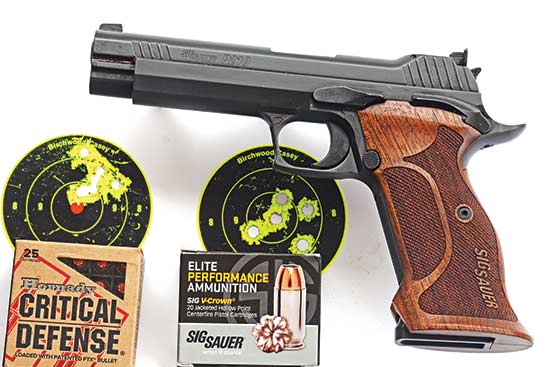
Here are 2″ 25-yard groups with a pair of state-of-the-art loads. Both are the better of two groups hand-held over a sandbag.
Bench Accuracy
My 25-yard bench shooting was done over a sandbag with a billfold for a butt rest. This imposes certain shooter-specific limitations on overall results. Groups resembled the results I had gotten with the German SIGs — a P226 X5 and a 210 Legend. Five-shot strings comfortably under 2″ were the expectation and I am unable to pronounce any of these pistols “Most Accurate.”
My best effort with the 210 Legend closely resembled their 25-meter sample target and came in at 1.1″. The best P226 X-5 group was 0.95″. The new American 210 laid 5 rounds of Hornady 115-grain Critical Defense into the same 0.95″ center-to-center spread. Groups with the SIG Elite Performance 115-gr. JHP and the Black Hills 115 and 124-gr. +P fell inside 1.1 to 1.2″. All of these groups were “the best-of-two efforts.”
In terms of velocity with the loads I tried, the Critical Defense clocked 1,154 fps, while the 115-gr. Buffalo Bore +P and the SIG Elite were comfortably over 1,300. P210 Target exhibited perfect function with all available loads ranging from generic ball at less than $10 per 50 rounds, to a broad selection of state-of-the-art high performance 9mm loads.
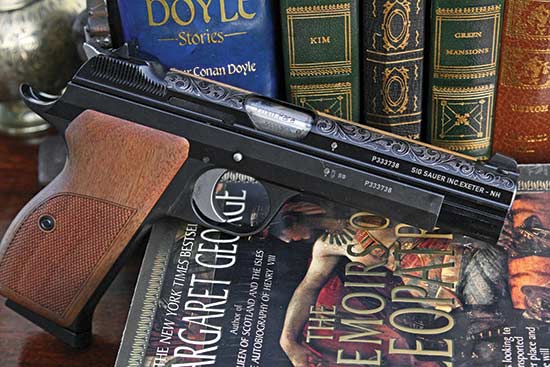
The SIG P210 Legend Limited from 2010 (left) contributed a comfortable beavertail to the original Swiss design. The high price limited stateside sales. The SIG P226 X5 (right) and similar pistols are more competition-centered, high-cap models made in Germany.
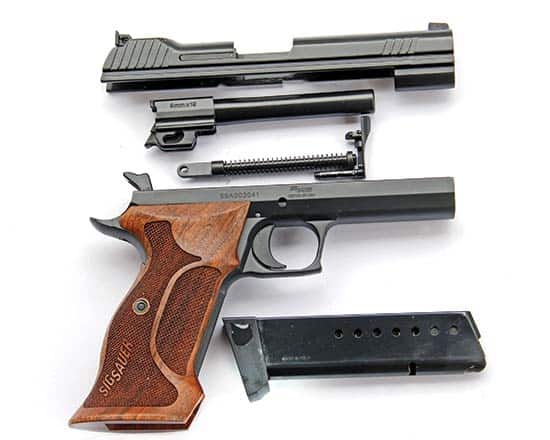
The slide rails ride inside of the frame, a factor often credited with the fine accuracy. The traditional, internal barrel/slide lugs have given way to the raised chamber/ejection port interface. It is just as accurate and more economical to produce.
Field and Target
The trigger on the P210 Target settled in at 3 lbs. 2 oz. after initial lubrication and shooting. There is an initial take-up of a fraction of an inch and a crisp let-off with additional pressure. I (and other shooters) found our first efforts could produce early let-offs, screwing up some of our initial offhand groups. As advertised, however, the match trigger and grips are well suited to either one- or two-handed shooting.
Several of us met at Kenny Hunt’s backyard range and went to work on his falling plate racks. These consist of 8″ circular plates addressed from 15 yards. Using generic 115-gr. ball, we slapped them down at a brisk and even cadence, with shot separation intervals of well under a second. Shooting standing with either one- or two-handed at 25 yards delivers gratifying results on paper.
The SIG 210 started out as a service pistol and the current Target Model does not fall far from that tree. Its utility as a competition tool does not — as is the case with many purpose-built guns — detract from its suitability for general use, including self-protection, small game/varmint shooting or just general recreation.
The American P210 Target shares the same superior quality and workmanship that has defined the Swiss and German pistols, and the ergonomics of safety and mag-release placement, plus the hand-protecting beavertail, are profound improvements over the earlier versions. The metal work is commensurate with the Swiss and German models and the PVD/Nitron treatment is far superior.
Largely due to domestic production and the adoption of the Peter Stahl-like barrel-to-slide locking system, the current P210 Target is available at a much lower price than its predecessors. The Swiss 49/210s now command collectors’ prices and the imported German Legend retailed for $2,200 to $2,800 for the limited-series availability for those who were lucky (or creative) enough to find them at all.
Still, the P210 Target’s MSRP of $1,699 (real world: $1,479-$1,500) plus the per-magazine cost of $120-plus keep it well out of the economy category.
Ken Luikart, a participant in our metal plate shoot is a confirmed SIG enthusiast. He vowed to start looking for a domestic P210 Target and will probably find one as they are listed as available at Cabela’s and via Guns America Internet as well as a number of other outlets. In recent years, I’ve used quite a few upscale 9mms.
This one will stay with me for the long haul.
SIG Sauer
Ph: (603) 610-3000













